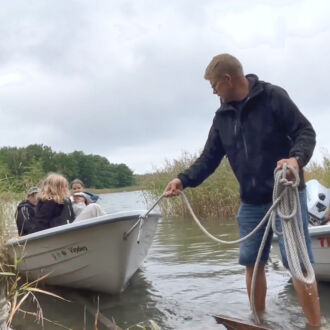Take a walk in the forest. Gather some berries and mushrooms to eat. Find a nice spot to pitch your tent overnight, and go for a refreshing swim in a lake.
In many countries, these things would only be possible in a designated recreational area, or with the landowner’s consent. In Finland, however, you don’t need to ask permission.
Thanks to the tradition of every person’s right, people in Finland enjoy extensive privileges for accessing nature practically anywhere, with few limitations.
A long history

Generations ago families supplemented their diets with seasonal foods from the forests.Photo: Terhi Tuovinen / Lapland MaterialBank
The term “everyman’s right,” which in recent years has been replaced with “every person’s right” or “everyone’s right,” was coined in the 1930s, but the concept is older and has evolved over a long time.
In preindustrial times, it was a question of getting your livelihood from the land. Gathering berries and mushrooms provided a means of maintaining some level of self-sufficiency.
Isojako (the Great Partition), a land reform carried out in the 18th century, established land ownership for areas that were previously commons without designated owners. The number of people without land of their own grew over the years. It was essential that they still be able to use other people’s land.
In modern times, the emphasis is more on recreational use of nature, but even today, an avid gatherer can save a lot of money by picking berries instead of buying them from the supermarket.
A patchwork of legislation

In modern times, every person’s right focuses on recreation in nature.Photo: Emilia Hoisko /Visit Finland
There is no single law in Finnish legislation that covers all aspects of every person’s right. Instead, several different laws either establish or restrict people’s rights in relation to nature.
For example, one section of the criminal code states that the paragraphs about theft do not apply to gathering fallen branches, fir cones or nuts, or to picking wild berries, mushrooms or flowers.
A court case from the early 20th century often receives attention as a landmark in establishing a legal precedent. It concerns Ilma Lindgren (1883–1957), a widowed mother of three, who supported her family by selling goods at the market.
In September 1914, Lindgren and three other women were gathering lingonberries (a wild relative of the cranberry) in the forests of Ruokolahti, in southeastern Finland. The local landowner demanded that the women hand over their harvest.
Lindgren had the guts to take the matter to court, including several appeals. While two lower-level courts ruled in favour of the landowner, the Supreme Court eventually decided otherwise, pointing out that “picking berries from another person’s land is not an act subject to punishment.”
Exceptions to the rule

Berry-picking is one of the most popular applications of every person’s right. About half of Finns pick berries every year.Photo: Virpi Mikkonen / Visit Finland
Every person’s right is quite extensive, but it has its limits, of course. With privilege comes responsibility, as the saying goes.
You’re not allowed to trespass in anybody’s garden or backyard or walk on plantings or cultivated land. You can’t disturb wildlife, damage trees or collect moss or lichen. Making a fire always requires permission from the landowner, and is completely forbidden if a wildfire warning is in effect.
National parks and other protected areas often adopt more specific restrictions in order to protect the fragile environment. For example, hiking may be restricted to marked trails, or to specific times of the year.
Fishing rights depend on the equipment you’re using. Fishing with a simple rod and line, including ice fishing, usually don’t require a permit, whereas more sophisticated methods do (nets, traps or a rod and reel). Hunting is regulated much more strictly.
Nordic neighbours have similar traditions

Mushroom season normally begins in late summer or early autumn. Many mushroom hunters keep their favourite spots secret.Photo: Jussi Hellsten / Helsinki Partners
Every person’s right is a firmly established custom in Finland. According to Hannu Tiusanen, senior specialist from the Finnish Outdoor Association Suomen Latu, the tradition is widely accepted, although there are some landowners who would prefer to receive compensation from people using their land.
Certain things make Finland favourable for maintaining the tradition. The country is relatively sparsely populated, with fewer than 19 inhabitants per square kilometre (48 inhabitants per square mile), and land ownership has traditionally been spread over a large number of small landowners. Roughly one in ten Finns owns some land.
Neighbouring Sweden and Norway have rather similar traditions. Denmark is much more densely populated and access rights are less extensive.
At its core, it is also a cultural issue, as Tiusanen points out. While some countries highlight the rights of the landowner, the Nordics emphasise the rights of the community – of every person.
By Juha Mäkinen, August 2024












